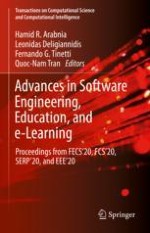2021 | OriginalPaper | Chapter
Change Request Prediction in an Evolving Legacy System: A Comparison
Authors : Lamees Alhazzaa, Anneliese Amschler Andrews
Published in: Advances in Software Engineering, Education, and e-Learning
Publisher: Springer International Publishing
Activate our intelligent search to find suitable subject content or patents.
Select sections of text to find matching patents with Artificial Intelligence. powered by
Select sections of text to find additional relevant content using AI-assisted search. powered by
